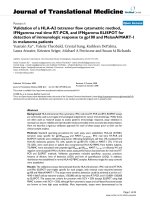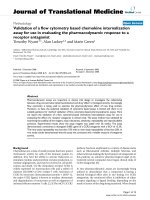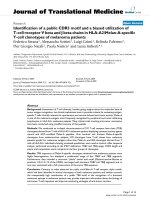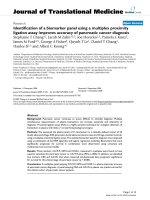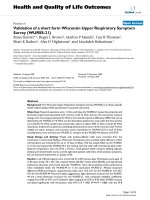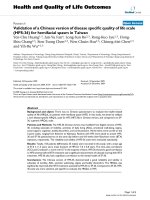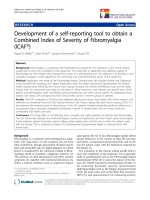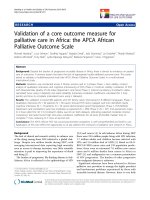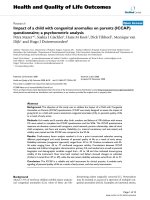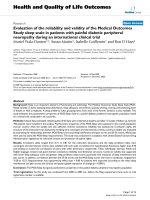báo cáo hóa học: " Reliability of a 1-week recall period for the Medical Outcomes Study Sleep Scale (MOS-SS) in patients with fibromyalgia" pptx
Bạn đang xem bản rút gọn của tài liệu. Xem và tải ngay bản đầy đủ của tài liệu tại đây (448.01 KB, 6 trang )
BioMed Central
Page 1 of 6
(page number not for citation purposes)
Health and Quality of Life
Outcomes
Open Access
Research
Reliability of a 1-week recall period for the Medical Outcomes Study
Sleep Scale (MOS-SS) in patients with fibromyalgia
Alesia Sadosky*
1
, Ellen Dukes
1
and Chris Evans
2
Address:
1
Pfizer Global Outcomes Research, 235 East 42nd Street, New York, NY 10017, USA and
2
Mapi Values, 15 Court Square, Suite 620,
Boston, MA 02108, USA
Email: Alesia Sadosky* - ; Ellen Dukes - ; Chris Evans -
* Corresponding author
Abstract
Objective: To evaluate the reliability of a one-week versus a four-week recall period of the
Medical Outcomes Study Sleep Scale (MOS-SS) in patients with fibromyalgia (FM).
Methods: The MOS-SS was administered by mail to patients with a confirmed diagnosis of FM and
a current pain rating of > 2 (0–10 point numerical rating scale) recruited through newspapers,
support groups, and the Internet. Reliability of MOS-SS subscale domains was evaluated using test-
retest methodology separated by a 1–3 day interval for the 4-week recall period and a 7-day
interval for the 1-week recall period. Patient Impression of Change was evaluated for sleep, and for
patients with no change, the intraclass correlation coefficient (ICC) and the Pearson correlation
coefficient was calculated for MOS-SS subscales.
Results: Of 129 patients enrolled, 91.3% were female, mean age was 49.4 ± 11.0 years; self-rated
FM severity was moderate-to-severe in 88.1% of patients. MOS-SS subscale scores were similar for
both recall periods with little variation between test-retest. The 9-item Sleep Problems Index
scores ranged from 57.2 ± 14.5 to 61.9 ± 15.8 across all assessments and demonstrated high
reliability which was similar for the 1-week (ICC 0.81) and 4-week (ICC 0.89) recall periods. For
the other MOS-SS subscales, the 1-week recall period also showed good reliability, which was
consistent for the ICC and Pearson correlation coefficients.
Conclusion: A 1-week recall period is adequately reliable for use of the MOS-SS in studies
evaluating sleep disturbance in patients with FM.
Although the etiology of fibromyalgia (FM) is uncertain,
it is generally diagnosed according to the American Col-
lege of Rheumatology (ACR) criteria, which include
chronic, widespread pain for at least 3 months, and the
presence of 11 out of 18 tender points [1]. It has been esti-
mated that approximately 5 million individuals in the
U.S. have FM, with a higher prevalence among women
(3.4%) than men (0.5%) [2]. In other countries, the prev-
alence of FM has been estimated to range between 0.5%
to 5%, also with a higher prevalence among women [3].
FM is associated with a substantial socioeconomic burden
resulting from excess health resource utilization, reduc-
tions in productivity and quality of life, and a health sta-
tus that is poorer than other chronic pain conditions such
as rheumatoid arthritis and osteoarthritis [4-7]. This bur-
Published: 10 February 2009
Health and Quality of Life Outcomes 2009, 7:12 doi:10.1186/1477-7525-7-12
Received: 29 August 2008
Accepted: 10 February 2009
This article is available from: />© 2009 Sadosky et al; licensee BioMed Central Ltd.
This is an Open Access article distributed under the terms of the Creative Commons Attribution License ( />),
which permits unrestricted use, distribution, and reproduction in any medium, provided the original work is properly cited.
Health and Quality of Life Outcomes 2009, 7:12 />Page 2 of 6
(page number not for citation purposes)
den is derived not only from the pain, which is character-
istic of FM and is considered the hallmark symptom, but
also from a constellation of other symptoms including
sleep disturbance, which after pain, is a major complaint
of patients with FM and may be an integral component of
the condition. Specific alterations in sleep architecture
have been documented in patients with FM by polysom-
nography [8-10], suggesting an association between sleep
dynamics and the underlying pathophysiology.
There is an overall reciprocal relationship between sleep
disturbance and pain [11-13], with correlation between
these outcomes reported in several rheumatologic condi-
tions including FM [14]. A recent study in patients with
FM suggests sleep disturbance may be predictive of pain
[15]. Not surprisingly, both pain and sleep are considered
core domains essential for evaluation in FM clinical trials
[16].
A variety of sleep instruments are available for evaluating
sleep disturbance and its impact [17], including a new
scale for evaluating restorative sleep (Sleep Quality Assess-
ment; SQA) [18]. A review of sleep assessment instru-
ments for use in chronic pain clinical trials suggested that
while none of the currently available instruments are opti-
mal, the Medical Outcomes Study Sleep Scale (MOS-SS)
[19] may represent the best choice [20]. This recommen-
dation was based on overlap between key sleep constructs
that should be evaluated with the domains that are
assessed by the MOS-SS.
The psychometric properties of the MOS-SS have been
evaluated in patients with a variety of conditions charac-
terized by pain including neuropathic pain [21,22], rest-
less legs syndrome [23], and fibromyalgia [24]. These
studies consistently demonstrated its validity and reliabil-
ity for assessing the key constructs of sleep quality and
quantity, and that it is also sensitive to change, suggesting
its utility in clinical trials. However, it has a recall period
of 4 weeks and responses may consequently be subject to
recall bias, potentially compromising the accuracy of
assessment. Such recall bias provides the basis for recom-
mendations by the FDA against the use of patient-
reported outcomes with long recall periods [25]. There-
fore, the purpose of this study was to evaluate the test-
retest reliability of a one-week recall period of the MOS-SS
compared with the four-week recall period in patients
with FM.
Methods
The MOS-SS was included in a stand-alone, longitudinal
study conducted between May and September 2007
designed to evaluate the psychometric properties of sev-
eral outcomes assessment instruments in patients with
FM. Patients were recruited through newspapers, support
groups, and the Internet, and were compensated for par-
ticipation. Individuals were included if they were ≥ 18
years old and provided a confirmed physician diagnosis
of FM for at least 3 months prior to enrollment; the par-
ticipants' clinicians forwarded written confirmation of the
diagnosis of FM to the study investigators. Individuals
were required to have a current pain rating of > 2 on an
11-point numerical rating scale (NRS) to enable enroll-
ment of individuals with a broad range of pain severity,
since another outcome of this study was validation of cut-
points representing moderate and severe pain as previ-
ously described [26]. It is also likely that use of this rating
resulted in a more representative population than limited
by the score ≥ 4 generally required for inclusion in clinical
trials of FM [27-33]. The ability to read/understand Eng-
lish and cooperate with investigators and study proce-
dures were also required. Exclusion criteria included a
previous diagnosis of rheumatoid arthritis or systemic
lupus erythematosus and/or any other chronic painful
condition that could confound the ability to distinguish
other chronic pain from pain related to FM. Eligible par-
ticipants completed informed consent and study partici-
pation forms; protocol and study documents were
approved by the appropriate Institutional Review Board.
The MOS-SS is a 12-item questionnaire that aims to eval-
uate key constructs of sleep, with derived subscales for the
domains of sleep disturbance (4 items), quantity of sleep
(1 item), snoring (1 item), awakening due to short of
breath or with headache (1 item), sleep adequacy (2
items), and somnolence (3 items) [19]. Additionally, a 9-
item Sleep Problems Index can be generated which
assesses overall sleep problems. It includes the 4 sleep dis-
turbance and the 2 sleep adequacy items, 2 of the somno-
lence items, and awakening short of breath/headache;
higher scores indicate greater sleep impairment, and this
index is often used in clinical trials as an indication of
sleep quality.
The MOS-SS was administered as a mailed questionnaire.
All patients completed both the 4-week and 1-week recall
period versions of the MOS-SS, with the 4-week recall
period questionnaires administered first. The test and
retest of the MOS-SS using the 4-week recall period were
separated by an interval that ranged between 1 and 3 days,
and for the 1-week recall period, the test and retest were
separated by a 7-day interval. At the time of the retest,
patients also evaluated their impression of change in sleep
(Patient Impression of Change; PIC) for the period
between the test and retest. The PIC was adapted from the
Patient Global Impression of Change for the purpose of
this study by specifying a change in sleep due to FM, but
was based upon methodology widely used to assess
degrees of change [34]. As with the PGIC, it is answered
on a 7-point scale of 1 = very much improved; 2 = much
Health and Quality of Life Outcomes 2009, 7:12 />Page 3 of 6
(page number not for citation purposes)
improved; 3 = minimally improved; 4 = no change; 5 =
minimally worse; 6 = much worse; 7 = very much worse.
Paired t-tests were used to determine significance of the
difference between test and retest scores. To evaluate test-
retest reliability of the subscales, the intraclass correlation
coefficient (ICC) using Shrout-Fleiss reliability (single-
score statistic) was calculated from paired values for each
recall period [35]. A value greater than the conventionally
accepted threshold of 0.70 was considered an indication
of reliability [36]. Pearson correlation coefficients were
also calculated as confirmation of the reliability estimates.
This assessment for reliability was performed on data
from stable subjects with respect to the PIC, i.e. patients
who reported "no change."
Results
A total of 129 patients with FM were enrolled; 91.3% were
female, and the mean age was 49.4 ± 11.0 years. Self-rated
FM severity was at least moderate in 88.1% of patients,
and 88.3% reported a duration of FM of at least 2 years
since diagnosis. Approximately two-thirds of the patients
(68.3%) reported taking medications for their FM.
The mean test and retest scores for the MOS-SS domains
and the 9-item Sleep Problem Index, along with general
US population norms that were derived in a validation
study using the 4-week recall period [21], are shown in
Figure 1. Scores were similar using the 4-week and 1-week
recall periods, and generally showed little variation
between the test and retest. The only significant differ-
ences between test and retest values were observed for the
domains of Daytime Somnolence (p = 0.0062) and the 9-
item Sleep Problems Index (p = 0.01) for the 4-week recall
period.
All domain scores for the 4-week recall period showed
substantial differences from population norms, indicating
the presence of sleep impairment. Sleep Disturbance and
Daytime Somnolence were the MOS-SS domains which
had the greatest negative impact on sleep quality for both
the 4-week and 1-week recall period. The Sleep Problems
Index scores, which are shown in Table 1, ranged from
57.2 ± 14.5 to 61.9 ± 15.8 across all assessments, and were
more than twice as high as reported for the general popu-
lation norm (25.8) [21], demonstrating substantial sleep
problems in these patients.
Although 60.4% and 56.9% of patients reported no
change in sleep status on the PIC between the test and
retest for the 4-week and 1-week recall periods, respec-
tively, improvement and worsening were both reported
Test and retest scores on the MOS-Sleep Scale for the 4-week and 1-week recall periodsFigure 1
Test and retest scores on the MOS-Sleep Scale for the 4-week and 1-week recall periods. General population
norms for the U.S. population (not adjusted for age and gender), shown as black horizontal bars, are provided for reference
from Hays et al. [21] only for the 4-week recall period, since population norms have not been established for a 1-week recall
period. * p = 0.0062 and † p = 0.01 for the difference between test and retest using paired t-tests.
0
10
20
30
40
50
60
70
Test Retest
General population norms
4-Week Recall Period 1-Week Recall Period
MOS Sleep Scale score
MOS Sleep Scale score
0
10
20
30
40
50
60
70
Sleep
disturbance
Snoring
Short of breath
or headache
Sleep
adequacy
Daytime
somnolence
Sleep
disturbance
Snoring
Short of breath
or headache
Sleep
adequacy
Daytime
somnolence
Sleep
Problems
Index
Sleep
Problems
Index
†
*
Health and Quality of Life Outcomes 2009, 7:12 />Page 4 of 6
(page number not for citation purposes)
by patients. For the 4-week recall period, 8.2% of patients
reported improvement and 23.8% reported worse sleep.
Similarly, for the 1-week recall period, 16.5% reported
improved sleep and 26.7% reported worse sleep.
The test-retest reliability of the MOS-SS domains and the
9-item Sleep Problems Index was assessed for the 78
patients (60.4%) and 62 patients (48.1%) who reported
no change on the PIC for the 4-week and 1-week recall
periods, respectively. The ICC and Pearson correlations
for these patients are shown in Table 2. Except for the
Sleep Adequacy domain, the ICC required threshold of
0.70 was exceeded for both recall periods with slightly
higher values for the 4-week period. For the Sleep Ade-
quacy domain, although the ICC did not achieve the
threshold value, the 1-week recall period resulted in a
higher value (0.69) than the 4-week recall period (0.63).
Values of the Pearson correlation coefficient were compa-
rable to the ICC.
Discussion
The MOS-SS is a validated instrument for evaluating the
impact of disease on sleep [19,21]. Its utility has been fur-
ther demonstrated in chronic pain conditions by charac-
terization of clinically important differences in patients
with neuropathic pain [22] and FM [24]. In an effort to
conform to recent recommendations for the use of
patient-reported instruments with short recall periods
[25], we evaluated the reliability of a 1-week recall period.
The data reported here indicate that the MOS-SS produces
comparable results regardless of the use of a 1-week or 4-
week recall period. All domains and the 9-item Sleep
Problems Index demonstrated adequate reliability that
was similar for both recall periods when no change
occurred in the underlying concept (e.g., sleep interfer-
ence). Similar values suggesting high correlation were
obtained for ICC and Pearson coefficients; ICC is consid-
ered a more conservative estimate of association than
Pearson.
A limitation of this study is that these reliability estimates
were based on patients who showed no change in sleep
status between the test and retest. While the MOS-SS in
general is sensitive to treatment effects, further evaluation
of the 1-week recall period may be required under condi-
tions characterized by a change in sleep disturbance (clin-
ical trials and clinical practice). However, it should be
noted that the psychometric evaluation of the MOS-SS in
patients with FM utilized data from two clinical trials, one
with a 4-week recall, and the other with a 1-week recall;
both recall periods showed similar psychometric charac-
teristics and sensitivity to change [24].
The fact that patients were compensated for participation
is another limitation which may have introduced bias,
since it is not known what effect the compensation may
have had on the selection of patients for this study.
Conclusion
The previously demonstrated psychometric soundness of
the MOS Sleep Scale subscales and overall Sleep Problems
Index combined with the current demonstration of the
reliability of a 1-week recall period suggests the appropri-
ateness of this instrument in the evaluation of sleep dis-
Table 1: Test and retest scores for the 9-item Sleep Problems Index of the Medical Outcomes Study Sleep Scale.
Recall period Test (n) Retest (n) Change (n) p
4 weeks 59.01 ± 14.85 (79) 57.23 ± 14.46 (79) -2.0 ± 6.7 (78) 0.01
1 week 61.9 ± 15.8 (62) 59.9 ± 15.2 (62) -2.0 ± 9.5 (62) 0.11
Table 2: Test-retest reliability of the Medical Outcomes Study Sleep Scale. Results are for stable subjects, defined as patients who
report 'No Change' on Patient Impression of Change sleep question, with non-missing values for both test and retest.
Domain 4-Week Recall 1-Week Recall
n Test-retest p
value
Intra-class
correlation
a
Pearson
correlation
n Test-retest p
value
Intra-class
correlation
a
Pearson
correlation
Sleep disturbance 78 0.1707 0.93 0.93 62 0.2354 0.76 0.76
Snoring 76 0.4385 0.90 0.90 61 0.0800 0.83 0.83
Awakening short of breath or
with headache
78 0.7412 0.87 0.87 62 0.6154 0.73 0.73
Sleep adequacy 78 0.2094 0.63 0.64 62 0.3619 0.69 0.69
Daytime somnolence 78 0.0062 0.88 0.89 62 0.1222 0.84 0.84
9-Item Sleep Problems Index 78 0.0100 0.89 0.90 62 0.1088 0.81 0.81
a
Calculated using Shrout-Fleiss reliability: single score statistic.
Health and Quality of Life Outcomes 2009, 7:12 />Page 5 of 6
(page number not for citation purposes)
turbance in patients with FM. However, further
corroboration of the reliability of a 1-week recall period in
clinical trials in patients with FM may be warranted.
Abbreviations
FM: fibromyalgia; MOS-SS: Medical Outcomes Study
Sleep scale; ICC: intraclass correlation coefficient; PIC:
Patient Impression of Change
Competing interests
Alesia Sadosky and Ellen Dukes are employees of Pfizer,
Inc.; Chris Evans is an employee of Mapi Values, an out-
comes research consulting company, which received
funding from Pfizer to perform the analysis.
Authors' contributions
All authors jointly contributed to the design of the study,
data analysis and interpretation of results, and develop-
ment of the manuscript. All authors have read and
approved the content of the final manuscript.
References
1. Wolfe F, Smythe HA, Yunus MB, Bennett RM, Bombardier C, Gold-
enberg DL, Tugwell P, Campbell SM, Abeles M, Clark P, et al.: The
American College of Rheumatology 1990 Criteria for the
Classification of Fibromyalgia. Report of the Multicenter Cri-
teria Committee. Arthritis Rheum 1990, 33(2):160-172.
2. Lawrence RC, Felson DT, Helmick CG, Arnold LM, Choi H, Deyo
RA, Gabriel S, Hirsch R, Hochberg MC, Hunder GG, et al.: Estimates
of the prevalence of arthritis and other rheumatic conditions
in the United States. Part II. Arthritis Rheum 2008, 58(1):26-35.
3. White KP, Harth M: Classification, epidemiology, and natural
history of fibromyalgia. Curr Pain Headache Rep 2001, 5(320–
329):.
4. Berger A, Dukes E, Martin S, Edelsberg J, Oster G: Characteristics
and healthcare costs of patients with fibromyalgia syn-
drome. Int J Clin Pract 2007, 61(9):1498-1508.
5. Hoffman DL, Dukes E: The health status burden of people with
fibromyalgia: a review of studies that assessed health status
with the SF-36 or the SF-12. Int J Clin Pract 2007, 62(1):115-126.
6. Verbunt JA, Pernot DH, Smeets RJ: Disability and quality of life in
patients with fibromyalgia. Health Qual Life Outcomes 2008, 6:8.
7. White LA, Birnbaum HG, Kaltenboeck A, Tang J, Mallett D, Robinson
RL: Employees with fibromyalgia: medical comorbidity,
healthcare costs, and work loss. J Occup Environ Med 2008,
50(1):13-24.
8. Burns JW, Crofford LJ, Chervin RD: Sleep stage dynamics in
fibromyalgia patients and controls. Sleep Med 2008,
9(6):689-696.
9. Landis CA, Lentz MJ, Rothermel J, Buchwald D, Shaver JLF:
Decreased sleep spindles and spindle activity in midlife
women with fibromyalgia and pain. Sleep 2004, 27(4):741-750.
10. Rizzi M, Sarzi-Puttini P, Atzeni F, Capsoni F, Andreoli A, Pecis M,
Colombo S, Carabba M, Sergi M: Cyclic alternating pattern: a
new marker of sleep alteration in patients with fibromyalgia?
J Rheumatol 2004, 31(6):
1193-1199.
11. McKracken LM, Iverson GL: Disrupted sleep patterns and daily
functioning in patients with chronic pain. Pain Res Manag 2002,
7(2):75-79.
12. Smith MT, Haythornthwaite JA: How do sleep disturbance and
chronic pain inter-relate? Insights from the longitudinal and
cognitive-behavioral clinical trials literature. Sleep Med Rev
2004, 8(2):119-132.
13. Edwards RR, Almeida DM, Klick B, Haythornthwaite JA, Smith MT:
Duration of sleep contributes to next-day pain report in the
general population. Pain 2008, 137(1):202-7.
14. Abad VC, Sarinas PSA, Guilleminault C: Sleep and rheumatologic
disorders. Sleep Med Rev 2008, 12:211-228.
15. Bigatti SM, Hernandez AM, Cronan TA, Rand KL: Sleep distur-
bances in fibromyalgia syndrome: Relationship to pain and
depression. Arthritis Rheum 2008, 59(7):961-967.
16. Mease P, Arnold LM, Bennett R, Boonen A, Buskila D, Carville S,
Chappell A, Choy E, Clauw D, Dadabhoy D, et al.: Fibromyalgia
syndrome. J Rheumatol 2007, 34(6):1415-1425.
17. Lomeli HAP-OI, Talero-Gutierrez C, Moreno CB, Gonzalez-Reyes R,
Palacios L, de la Pena F, Munoz-Delgado J: Sleep evaluation scales
and questionnaires: a review. Actas Esp Psiquiatr 2008,
36(1):50-59.
18. Taýeb C, Boussetta S, Roué-Le Lay K, André E, Caubère JP, Moldofsky
H: Fibromyalgia: restorative effect of sleep: validation of the
SQA (Sleep Quality Assessment). [abstract]. Ann Rheum Dis
2008, 67(Suppl II):258.
19. Hays R, Stewart A: Sleep measures. In Measuring Functioning and
Well-Being: the Medical Outcomes Study Approach Edited by: Stewart A,
Ware J. Durham, NC: Duke University Press; 1992:235-259.
20. Cole JC, Dubois D, Kosinski M: Use of patient-reported sleep
measures in clinical trials of pain treatment: a literature
review and synthesis of current sleep measures and a con-
ceptual model of sleep disturbance in pain. Clin Ther 2007,
19(Suppl):2580-2588.
21. Hays RD, Martin SA, Sesti AM, Spritzer KL: Psychometric proper-
ties of the Medical Outcomes Study Sleep measure. Sleep
Med 2005, 6(1):41-44.
22. Rejas J, Ribera MV, Ruiz M, Masrramon X: Psychometric proper-
ties of the MOS (Medical Outcomes Study) Sleep Scale in
patients with neuropathic pain. Eur J Pain 2007, 11(3):329-340.
23. Allen RP, Kosinski M, Hill-Zabala CE, Calloway MO: Psychometric
evaluation and tests of validity of the Medical Outcomes
Study 12-item Sleep Scale (MOS sleep). Sleep Med 2008 in
press.
24. Cappelleri JC, Bushmakin AG, McDermott AM, Dukes E, Sadosky A,
Petrie CD, Martin S: Measurement properties of the Medical
Outcomes Sleep Scale in patients with fibromyalgia. Sleep
Med 2009 in press.
25. Guidance for Industry. Patient-Reported Outcome Meas-
ures: Use in Medical Product Development to Support Labe-
ling Claims. [Draft] [ />5460dft.htm]
26. Zelman D, Dukes E, Brandenburg N, Bostrom A, Gore M: Identifi-
cation of cut-points for mild, moderate and severe pain due
to diabetic peripheral neuropathy. Pain 2005, 115(2):29-36.
27. Crofford LJ, Rowbotham MC, Mease PJ, Russell IJ, Dworkin RH,
Corbin AE, Young JP Jr, LaMoreaux LK, Martin SA, Sharma U, et al.:
Pregabalin for the treatment of fibromyalgia syndrome:
results of a randomized, double-blind, placebo-controlled
trial. Arthritis Rheum 2005, 52(4):1264-1273.
28. Arnold L, Pritchett YL, D'Souza DN, Goldstein DJ, Iyengar S, Wer-
nicke JF: A randomized, double-blind, placebo-controlled trial
of duloxetine in the treatment of women with fibromyalgia
with or without major depressive disorder. Pain 2005,
119:5-15.
29. Arnold LM, Goldenberg D, Stanford SB, Lalonde JK, Sandhu HS, Keck
PE Jr, Welge JA, Bishop F, Stanford KE, Hess EV, et al.: Gabapentin
in the treatment of fibromyalgia. A randomized, double-
blind, placebo-controlled, multicenter trial. Arthritis Rheum
2007, 56(4):1336-1344.
30. Arnold LM, Lu Y, Crofford LJ, Wohlreich M, Detke MJ, Iyengar S,
Goldstein DJ: A double-blind, multicenter trial comparing
duloxetine with placebo in the treatment of fibromyalgia
patients with or without major depressive disorder. Arthritis
Rheum 2004, 50(9):2974-2984.
31. Arnold LM, Russell IJ, Diri EW, Duan WR, Young JP, Sharma U, Martin
SA, Barrett JA, Haig G: A 14-week, randomized, double-blind,
placebo-controlled monotherapy trial of pregabalin in
patients with fibromyalgia. J Pain 2008, 9(9):792-805.
32. Russell IJ, Mease PJ, Smith TR, Kajdasz DK, Wohlreich MM, Detke MJ,
Walker DJ, Chappell AS, Arnold LM: Efficacy and safety of
duloxetine for treatment of fibromyalgia in patients with or
without major depressive disorder: Results from a 6-month,
randomized, double-blind, placebo-controlled, fixed-dose
trial. Pain 2008, 136(3):432-444.
33. Crofford LJ, Mease PJ, Simpson SL, Young JP Jr, Martin SA, Haig GM,
Sharma U: Fibromyalgia relapse evaluation and efficacy for
durability of meaningful relief (FREEDOM): A 6-month, dou-
Publish with BioMed Central and every
scientist can read your work free of charge
"BioMed Central will be the most significant development for
disseminating the results of biomedical research in our lifetime."
Sir Paul Nurse, Cancer Research UK
Your research papers will be:
available free of charge to the entire biomedical community
peer reviewed and published immediately upon acceptance
cited in PubMed and archived on PubMed Central
yours — you keep the copyright
Submit your manuscript here:
/>BioMedcentral
Health and Quality of Life Outcomes 2009, 7:12 />Page 6 of 6
(page number not for citation purposes)
ble-blind, placebo-controlled trial with pregabalin. Pain 2008,
136(3):419-431.
34. Guy W: ECDEU assessment manual for psychopharmacol-
ogy, revised. US Department of Health, Education, and Wel-
fare publication (ADM). Rockville, MD: National Institute of
Mental Health; 1976.
35. Shrout PE, Fleiss JL: Intraclass correlations: uses in assessing
rater reliability. Psychol Bull 1979, 86(2):430-428.
36. Chinchilli VM, Martel JK, Kumanyika S, Lloyd T: A weighted con-
cordance correlation coefficient for repeated measurement
designs. Biometrics 1996, 52:341-353.
